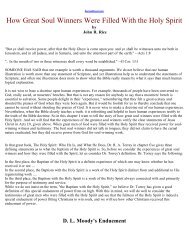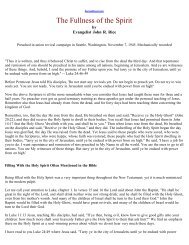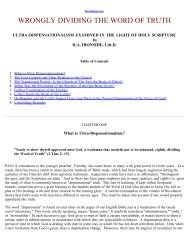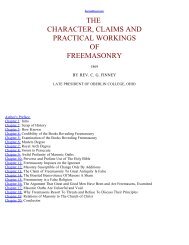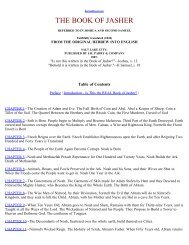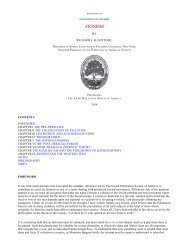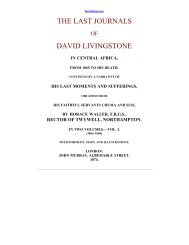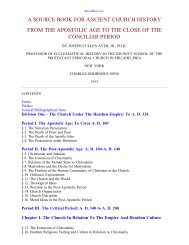Legends of Babylon and Egypt in Relation to Hebrew Tradition.pdf
Legends of Babylon and Egypt in Relation to Hebrew Tradition.pdf
Legends of Babylon and Egypt in Relation to Hebrew Tradition.pdf
You also want an ePaper? Increase the reach of your titles
YUMPU automatically turns print PDFs into web optimized ePapers that Google loves.
<strong>and</strong> Enmerkar's father was high priest as well as k<strong>in</strong>g.<br />
[3] i.e. Tammuz.<br />
[4] i.e. Gilgamesh.<br />
[5] The name <strong>of</strong> the father <strong>of</strong> Gilgamesh is rather strangely expressed by the s<strong>in</strong>gle sign for the vowel /a/ <strong>and</strong> must<br />
apparently be read as A. As there is a small break <strong>in</strong> the text at the end <strong>of</strong> this l<strong>in</strong>e, Dr. Poebel not unnaturally assumed<br />
that A was merely the first syllable <strong>of</strong> the name, <strong>of</strong> which the end was want<strong>in</strong>g. But it has now been shown that the<br />
complete name was A; see Förtsch, /Orient. Lit.-Zeit./, Vol. XVIII, No. 12 (Dec., 1915), col. 367 ff. The read<strong>in</strong>g is<br />
deduced from the follow<strong>in</strong>g entry <strong>in</strong> an Assyrian explana<strong>to</strong>ry list <strong>of</strong> gods (/Cun. Texts <strong>in</strong> the Brit. Mus./, Pt. XXIV, pl.<br />
25, ll. 29-31): "The god A, who is also equated <strong>to</strong> the god Dubbisaguri (i.e. 'Scribe <strong>of</strong> Ur'), is the priest <strong>of</strong> Kullab; his<br />
wife is the goddess N<strong>in</strong>guesirka (i.e. 'Lady <strong>of</strong> the edge <strong>of</strong> the street')." A, the priest <strong>of</strong> Kullab <strong>and</strong> the husb<strong>and</strong> <strong>of</strong> a<br />
goddess, is clearly <strong>to</strong> be identified with A, the priest <strong>of</strong> Kullab <strong>and</strong> father <strong>of</strong> Gilgamesh, for we know from the<br />
Gilgamesh Epic that the hero's mother was the goddess N<strong>in</strong>sun. Whether N<strong>in</strong>guesirka was a title <strong>of</strong> N<strong>in</strong>sun, or<br />
represents a variant tradition with regard <strong>to</strong> the parentage <strong>of</strong> Gilgamesh on the mother's side, we have <strong>in</strong> any case<br />
confirmation <strong>of</strong> his descent from priest <strong>and</strong> goddess. It was natural that A should be subsequently deified. This was not<br />
the case at the time our text was <strong>in</strong>scribed, as the name is written without the div<strong>in</strong>e determ<strong>in</strong>ative.<br />
[6] Possibly 186 years.<br />
This group <strong>of</strong> early k<strong>in</strong>gs <strong>of</strong> Erech is <strong>of</strong> exceptional <strong>in</strong>terest. Apart from its <strong>in</strong>clusion <strong>of</strong> Gilgamesh <strong>and</strong> the gods<br />
Tammuz <strong>and</strong> Lugalb<strong>and</strong>a, its record <strong>of</strong> Mesk<strong>in</strong>gasher's reign possibly refers <strong>to</strong> one <strong>of</strong> the lost legends <strong>of</strong> Erech. Like<br />
him Melchizedek, who comes <strong>to</strong> us <strong>in</strong> a chapter <strong>of</strong> Genesis reflect<strong>in</strong>g the troubled times <strong>of</strong> <strong>Babylon</strong>'s First Dynasty,[1]<br />
was priest as well as k<strong>in</strong>g.[2] <strong>Tradition</strong> appears <strong>to</strong> have credited Mesk<strong>in</strong>gasher's son <strong>and</strong> successor, Enmerkar, with the<br />
build<strong>in</strong>g <strong>of</strong> Erech as a city around the first settlement Eanna, which had already given its name <strong>to</strong> the "k<strong>in</strong>gdom". If so,<br />
Sumerian tradition confirms the assumption <strong>of</strong> modern research that the great cities <strong>of</strong> <strong>Babylon</strong>ia arose around the still<br />
more ancient cult-centres <strong>of</strong> the l<strong>and</strong>. We shall have occasion <strong>to</strong> revert <strong>to</strong> the traditions here recorded concern<strong>in</strong>g the<br />
parentage <strong>of</strong> Mesk<strong>in</strong>gasher, the founder <strong>of</strong> this l<strong>in</strong>e <strong>of</strong> k<strong>in</strong>gs, <strong>and</strong> that <strong>of</strong> its most famous member, Gilgamesh.<br />
Meanwhile we may note that the clos<strong>in</strong>g rulers <strong>of</strong> the "K<strong>in</strong>gdom <strong>of</strong> Eanna" are want<strong>in</strong>g. When the text is aga<strong>in</strong><br />
preserved, we read <strong>of</strong> the hegemony pass<strong>in</strong>g from Erech <strong>to</strong> Ur <strong>and</strong> thence <strong>to</strong> Awan:<br />
The k[<strong>in</strong>gdom <strong>of</strong> Erech[3] passed <strong>to</strong>] Ur. In Ur Mesannipada became k<strong>in</strong>g <strong>and</strong> ruled for eighty years. Meskiagunna,<br />
son <strong>of</strong> Mesannipada, ruled for thirty years. Elu[. . .] ruled for twenty-five years. Balu[. . .] ruled for thirty-six years.<br />
Four k<strong>in</strong>gs (thus) ruled for a hundred <strong>and</strong> seventy-one years. The k<strong>in</strong>gdom <strong>of</strong> Ur passed <strong>to</strong> Awan. In Awan . . .<br />
[1] Cf. /Hist. <strong>of</strong> Bab./, p. 159 f.<br />
[2] Gen. xiv. 18.<br />
[3] The res<strong>to</strong>ration <strong>of</strong> Erech here, <strong>in</strong> place <strong>of</strong> Eanna, is based on the absence <strong>of</strong> the latter name <strong>in</strong> the summary; after<br />
the build<strong>in</strong>g <strong>of</strong> Erech by Enmerkar, the k<strong>in</strong>gdom was probably reckoned as that <strong>of</strong> Erech.<br />
With the "K<strong>in</strong>gdom <strong>of</strong> Ur" we appear <strong>to</strong> be approach<strong>in</strong>g a firmer his<strong>to</strong>rical tradition, for the reigns <strong>of</strong> its rulers are<br />
recorded <strong>in</strong> decades, not hundreds <strong>of</strong> years. But we f<strong>in</strong>d <strong>in</strong> the summary, which concludes the ma<strong>in</strong> copy <strong>of</strong> our<br />
Dynastic List, that the k<strong>in</strong>gdom <strong>of</strong> Awan, though it consisted <strong>of</strong> but three rulers, is credited with a <strong>to</strong>tal duration <strong>of</strong><br />
three hundred <strong>and</strong> fifty-six years, imply<strong>in</strong>g that we are not yet out <strong>of</strong> the legendary stratum. S<strong>in</strong>ce Awan is proved by<br />
newly published his<strong>to</strong>rical <strong>in</strong>scriptions from Nippur <strong>to</strong> have been an important deity <strong>of</strong> Elam at the time <strong>of</strong> the<br />
Dynasty <strong>of</strong> Akkad,[1] we gather that the "K<strong>in</strong>gdom <strong>of</strong> Awan" represented <strong>in</strong> Sumerian tradition the first occasion on<br />
which the country passed for a time under Elamite rule. At this po<strong>in</strong>t a great gap occurs <strong>in</strong> the text, <strong>and</strong> when the<br />
detailed dynastic succession <strong>in</strong> <strong>Babylon</strong>ia is aga<strong>in</strong> assured, we have passed def<strong>in</strong>itely from the realm <strong>of</strong> myth <strong>and</strong><br />
legend <strong>in</strong><strong>to</strong> that <strong>of</strong> his<strong>to</strong>ry.[2]<br />
[1] Poebel, /Hist. Inscr./, p. 128.



